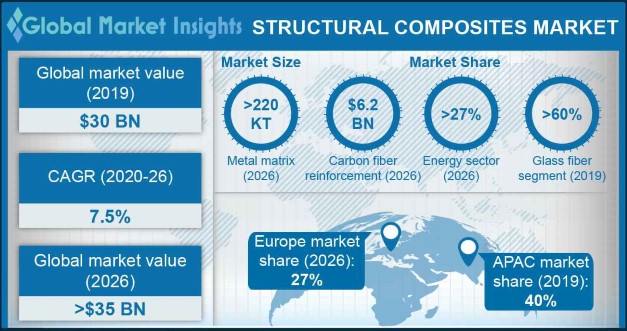Home > Construction > Construction Materials > Roofing Materials > Structural Composites Market
Structural Composites Market Size
- Report ID: GMI4678
- Published Date: May 2020
- Report Format: PDF
Structural Composites Market Size
Structural Composites Market size was valued over USD 30 billion in 2019 and is estimated to exhibit CAGR above 7.5% from 2020 to 2026. Increasing importance and investment on renewable energy sources across the world will boost the product usage in coming years.
Proliferating wind energy sector is the chief factor prospering the structural composites market growth. China has the largest installed wind energy capacity over 220 gigawatts (GW), followed by the U.S., Germany, India, Spain and UK. China has the largest onshore-wind farm in the word with 7,965 megawatt (MW) capacity, five times larger than its closest rival. The U.S. has six of the ten largest onshore wind farms and installed wind energy capacity of over 95GW. This product is extensively used to produce stronger, lighter, and longer blades and nacelles of wind turbines.
| Report Attribute | Details |
|---|---|
| Base Year: | 2019 |
| Structural Composites Market Size in 2019: | 30.03 Billion (USD) |
| Forecast Period: | 2020 to 2026 |
| Forecast Period 2020 to 2026 CAGR: | 7.6% |
| 2026 Value Projection: | 36.9 Billion (USD) |
| Historical Data for: | 2016 to 2019 |
| No. of Pages: | 120 |
| Tables, Charts & Figures: | 158 |
| Segments covered: | Matrix, Reinforcement Materials, Sector, Region |
| Growth Drivers: |
|
| Pitfalls & Challenges: |
|
With Paris Agreement, the world is moving towards clean energy sources to reduce greenhouse effect and global warming. Costs of renewable energy sources are falling at a substantial rate. Wind energy is a form of inexhaustible, clean and increasingly competitive energy source. It differs from the principle of fossil fuels diversity and abundance potential of usage. It could exceed 2100 GW and is likely to produce 20% of the global electricity by 2030. It could attract an investment of over USD 200 billion and will help to reduce carbon dioxide emission by more than 3.3 billion tons annually.
However, high cost associated with the product might hinder the product consumption in coming years. Additionally, the outbreak of COVID-19 pandemic has adversely affected major industries such as construction, energy, etc. across the globe. Manufacturing facilities for automotive, aerospace & defense and marine production have temporarily closed due to logistical imbalances and unavailability of workers.
Furthermore, as numerous companies depend on materials from China, the restriction on international trades and supply chain disruption has significantly affected the structural composites market production.

